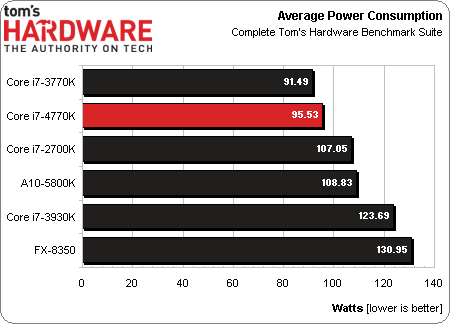The Core i7-4770K Review: Haswell Is Faster; Desktop Enthusiasts Yawn
Intel's Haswell architecture is finally available in the flagship Core i7-4770K processor. Designed to drop into an LGA 1150 interface, does this new quad-core CPU warrant a complete platform replacement, or is your older Sandy Bridge-E system better?
Power Consumption
As an architecture, Haswell is being lauded for enabling the “biggest battery life increase in Intel’s history.” But of course, battery life isn’t a consideration on the desktop. Larger form factors that aren’t power-constrained give Intel more headroom to offer higher thermal ceilings (which is why we have Sandy Bridge-E-based chips rated for 130 W).
Core i7-4770K’s TDP is 84 W, 7 W higher than the 77 W Core i7-3770K. But it also employs on-package voltage regulation, moving components previously on the motherboard into the processor itself. How does this translate to efficiency?
First, let’s look at our complete benchmark run, graphed out over time.
We’re truncating the end of the chart for readability, but essentially, AMD’s A10-5800K trails off at the end, taking far longer to finish all of our workloads than any other processor. The big spikes are indicative of where 3DMark is running, so we can see Core i7-3930K got there first, followed by Core i7-4770K, with Core i7-3770K and -2700K not far behind.
Other landmarks are more difficult to identify, though we do see the FX-8350- and Core i7-3930K-powered systems averaging much higher draw from the wall than other platforms. The difference, of course, is that Sandy Bridge-E also finishes the suite notably faster than Piledriver.
The script we use for testing builds in short idle periods between benchmarks, which, more than anything, is necessary for slower systems so that they don’t fail taking too long to shut down or launch certain applications. Even still, if we averaged power consumption during the entirety of our run, you’d come away thinking that these platforms were hogs, since most of the time they’d be active. We add 1,800 seconds (30 minutes) of idle time to the back end before shutting each system off automatically.
With this idle time factored in, each GTX Titan-equipped platform draws what we’d consider to be a reasonable amount of power for high-end hardware performing a number of demanding tasks. The Core i7-3770 predictably achieves the lowest consumption result thanks to its 77 W TDP. Next is the 84 W Core i7-4770K, followed by Intel’s 95 W Core i7-2700K.
Get Tom's Hardware's best news and in-depth reviews, straight to your inbox.
Because we also know that each sample represents two seconds, we also know exactly how long each system is powered on. So, we can take that figure, multiply it by the average power consumption, and get an idea of how much power was used during each run. Again, it appears that Intel’s Core i7-3770K leads the way, with -4770K behind.
Update (6/4): Special thanks to Tom's Hardware reader mikitd, who noticed the -4770K's Wh result seemed high. We revisited the logs, and found one test that was left enabled on the Haswell-based system, extending its run time while generating a result we weren't using. We've since re-run the test and now show Haswell and Ivy Bridge consuming roughly the same power. Although -4770K still averages higher consumption, its performance improvement helps compensate.
A look at the logs suggests that the Haswell-based chip isn’t idling as low as the -3770K, even though all power-savings features are enabled in both motherboard UEFIs.
Current page: Power Consumption
Prev Page Results: Media Encoding Next Page Core i7-4770K: Did I Shave My Legs For This?-
Danny N Biggest question is if its worth upgrading my cpu i5 750 4.0ghz to Haswell or my gfx card ati 5870 to nvidia 7xx, my main pc use is for Maya, After FX and some fps gaming. Any input would be appriciated cause I'm leaning towards a cpu upgrade atm.Reply -
refillable @Danny NReply
You shouldn't ask here. Perhaps you should get an i7-4770k and a 7970(?) I heard that kepler cards does not perform that good in Maya and Aftereffects (In OpenCL). -
envy14tpe Seriously. What did people expect? Of course it's better but nothing out of the ordinary for Intel.Reply -
enewmen For me it's not about the 10% gain over SB. It's more like a huge gain over a C2Q, floating point performance over SB (should matter later), and lower watts. I hope THG can expand the Power Consumption and Media Encoding later - check the Watts idle more and fast quick-sync media encoding quality loss. My 2 cents..Reply
EDIT:
other sites have reported much lower watts idle, so a lot doesn't make sense or the 4770k has a very slow throttle.
http://hexus.net/tech/reviews/cpu/56005-intel-core-i7-4770k-22nm-haswell/?page=15
http://www.techspot.com/review/679-intel-haswell-core-i7-4770k/page13.html



